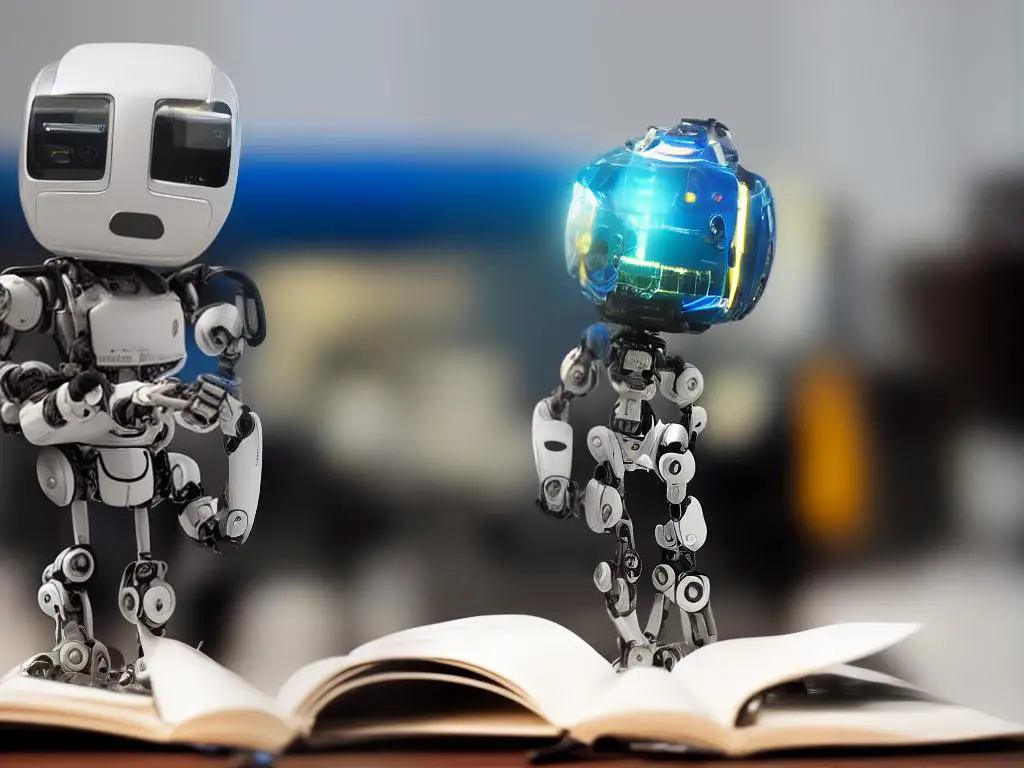As technology advances, the ability of artificial intelligence (AI) to generate content that mimics human writing becomes increasingly sophisticated. As a responsible and discerning reader, it’s important to learn how to identify AI-generated content and distinguish it from human-authored articles. This guide will introduce you to the basics of AI-generated content, discuss common patterns and inconsistencies, teach you how to evaluate the credibility of information, and explore various text analysis tools and plagiarism checkers. By honing these skills, you’ll be better prepared to assess the authenticity of articles you encounter online.
Basics of AI-generated content
Understand the technology behind AI-generated content
The most widely used language models for generating text today are called GPT-3 (Generative Pre-trained Transformer 3) and Transformers. Both of these models are based on a neural network architecture, using machine learning to analyze vast amounts of data and generate text that is contextually relevant and coherent. Moreover, these models have been pre-trained on a large corpus of text, enabling them to understand word patterns and associations.
Recognize features of AI-generated content
Though AI-generated content can often seem quite realistic, there are specific characteristics to look out for that can help you identify it:
- Repetitive language: AI-generated articles may sometimes contain repetitive phrases or words that do not provide any new information.
- Use of vague or generalized statements: AI-generated content might lack specific details and concrete examples, opting for broad terms or generalizations instead of precise information.
- Lack of sources or citations: AI-generated articles may not contain any sources or citations for the information provided, making it difficult to verify the information’s authenticity.
- Odd phrasing or syntax: AI-generated text may exhibit odd sentence structures or uncommon word usage, resulting in text that does not flow as smoothly as human-written content.
- Inconsistencies in content: AI-generated articles may show inconsistencies in the information provided, either within the article or when compared to other sources on the topic.
Verify the author and publication
To protect yourself from consuming AI-generated content, verify whether the author and publication are legitimate. Search for the author’s name to see if they have any other work or a social media presence. Additionally, verify if the publication is reputable and check other articles on the same topic to ensure consistency.
Cross-reference information
When reading an article, cross-reference the information provided with other sources to ensure it’s accurate and reliable. If the article contains information that seems false or exaggerated, it could be AI-generated content.
Use AI-generated content detection tools
Several AI-generated content detection tools, such as OpenAI’s GPT-3 Detector or GLTR (Giant Language Model Test Room), can help detect whether an article is AI-generated. These tools analyze the text for specific patterns and features found in AI-generated content, giving you an assessment of the likelihood that the content was produced by AI.

Common patterns and inconsistencies
Analyze the Title and Headings: AI-generated articles might have titles and headings that are too generic, oddly phrased, or loosely related to the content of the article. Pay attention to any unusual capitalization or punctuation, as well.Check for Coherence and Flow: AI-generated articles might lack a logical flow or coherence in the information presented. Look for sections that seem out of place, jump abruptly from one topic to another without proper transitions, or contain contradictory information.Look for Grammatical and Syntax Errors: While AI-generated articles can generally produce grammatically correct sentences, they can sometimes create odd or incorrect sentence structures, subject-verb agreement issues, and incorrect verb tenses.Examine Word Choice: A common sign of AI-generated content is the use of unusual or repetitive words and phrases. The text might also contain synonyms used incorrectly or awkwardly attempted paraphrasing. An AI-generated article might use overly formal language where it is not appropriate or rely heavily on a limited vocabulary.Identify Overuse of Jargon: An AI-generated article may contain an excessive use of industry-specific jargon or technical terms, making the content harder to understand. This could be an attempt to appear more knowledgeable on the topic.Evaluate Consistency in Tone and Style: AI-generated articles may struggle to maintain a consistent tone and writing style throughout the piece. Look for sudden shifts in the formality, language register, or overall “voice” in the article.Look for Repetition: AI-generated text may employ repetitive words, phrases, or sentence structures. Additionally, the content might repeat the same idea or concept in different ways, without adding any new or valuable information.Search for Missing or Incorrect Information: AI-generated articles may contain factual errors or outdated information. Verify the accuracy of the article by checking the supporting references and quoted sources, if provided.Analyze the Overall Structure: AI-generated articles might have structural inconsistencies, like multiple introductions or conclusions, a lack of proper headings, or paragraphs that lack a coherent theme or main idea.Check the Author and Publication: Always pay attention to the author and the publication source. AI-generated content might be less likely to have an author with expertise in the topic or come from a reputable source. Do a bit of research on the author’s background and credibility, as well as the publication’s reputation and reliability.By becoming familiar with these common patterns and inconsistencies, you’ll be better equipped to discern between AI-generated content and articles written by human authors. Keep in mind, however, that AI-generated text is continually improving, and it may become increasingly more challenging to differentiate between the two. Always practice critical thinking and verify the information you consume.

Fact-checking and source evaluation
Analyze the article’s language and style.
- Check for unnatural language: AI-generated content may have unnatural sounding or awkward phrasing. Be on the lookout for sentences that seem machine-generated, repetitive, or out of context.
- Look for inconsistencies in tone or style: A human author typically maintains a coherent writing style and tone throughout an article. An AI-generated article may have inconsistencies in tone or abrupt changes in style that are unusual for a human-written piece.
Fact-check the content.
- Verify factual claims: Research the credibility of the facts, statistics, and arguments presented in the article. Cross-reference with multiple sources to validate the accuracy of the information.
- Confirm quotes and statements: AI-generated articles may create fabricated or misattributed quotes. If the article contains quotes from prominent figures or experts, verify the authenticity of the quotes using credible sources.
Evaluate the sources cited in the article.
- Check the credibility of the sources: Investigate the sources cited within the content. Are they reputable and reliable? Be cautious if the article cites an abundance of unknown or unreliable sources.
- Look for missing citations: AI-generated articles may lack proper citations or provide very few sources. A well-researched, human-written article will typically include multiple citations from reputable sources.
Investigate the author and publication.
- Research the author: Look up the author’s credentials, past work, and online presence. Be skeptical if the author has a limited or nonexistent online presence, as it may indicate a fake persona created by AI.
- Analyze the publication: Research the publication’s credibility and reputation. Pay attention to factors like the publisher’s editorial guidelines, the presence of a thorough fact-checking process, and the quality of other articles on the site.
Employ critical thinking skills.
- Question the article’s motive: Understanding the purpose behind the content can help you determine its credibility. Ask yourself if the article is trying to persuade, inform, or entertain you, and whether it achieves its purpose effectively.
- Use your intuition: As you read, pay attention to any feelings of uneasiness or suspicion that arise. Trusting your instincts coupled with the steps outlined above can help you differentiate between AI-generated and authentic content.

Grammar and tone consistency
Start by familiarizing yourself with typical writing styles. Spend some time reading articles from reputable sources, such as newspapers, magazines, and online publications that are known for their quality writing and editorial standards.Identify the main purpose and tone of the article. Be on the lookout for fluctuations in tone, structure, and point of view.Look for awkward phrasing or syntax. Be aware of excessively complex sentences or grammar mistakes that are unlikely for a human to make.Examine vocabulary and word choice. Be wary of overly repetitive language, advanced terminology without explanation, or synonyms that don’t fit the context.Analyze the flow and connection between paragraphs. Ensure a logical order by examining transitions. Disjointed articles may lack a coherent narrative.Check for factual inconsistencies or unrealistic claims. Be on the lookout for unsupported statements, factual inconsistencies, or a lack of citations and references.Evaluate the conclusion and overall coherence. Look for any abrupt endings, unanswered questions or an ineffective wrap-up of main points.Cross-reference the article. Compare the content of the article with other reputable sources discussing the same topic. Inconsistencies in grammar, tone, and writing style may indicate AI-generation.

Lack of emotional depth and personal anecdotes
Determining if an article is AI-generated can sometimes be challenging, as artificial intelligence has come a long way in mimicking human language. However, one key aspect where AI-generated content falls short is in emotional depth and personal anecdotes. In this guide, we’ll discuss how to recognize the absence of these elements in order to assess if an article is AI-generated or human-written.Step 1: Analyze the Writing Style
1. Look for consistent and repetitive language. AI-generated articles tend to have repetition in sentence structures and phrases, making the content sound robotic or formulaic.
2. Examine the variety of vocabulary used. Human writers typically use a wider range of word choices and expressions, while AI-generated content might use the same words and phrases repeatedly.
3. Check if the tone is impersonal and objective. Although not all human-written articles are personal, AI-generated content often lacks the emotional nuances that humans naturally include when expressing thoughts and ideas.Step 2: Look for Absence of Emotional Depth
1. Pay attention to the way emotions are expressed in the article. AI-generated content may mention emotions but not delve into them deeply, missing the subtleties and nuances that human-written articles often have.
2. Analyze the complexity of emotions discussed. If the article only describes basic emotions, such as happiness or sadness, it might be AI-generated. Human writers often delve into more complex emotional states, such as empathy, nostalgia, and ambivalence.
3. Question the authenticity of any emotional statements. If the article includes emotional expressions that seem hollow or disconnected from the subject matter, it might be AI-generated.Step 3: Check for a Lack of Personal Anecdotes
1. Look for instances where the author shares personal stories or experiences. AI-generated articles tend to lack these elements, as algorithms cannot create unique personal narratives.
2. Analyze the depth of any anecdotes provided. If the article includes personal anecdotes, assess if they are superficial or generic. AI-generated content often struggles to create detailed and realistic personal stories.
3. Pay attention to the author’s voice and style. Human writers often have a distinct voice that comes through in their writing, including personal perspectives, humor, and insights. If these elements are missing, the article might be AI-generated.Step 4: Evaluate the Overall Coherence and Flow
1. Check if the article maintains a consistent flow of ideas and concepts. AI-generated content might seem disjointed, as it tends to jump from one point to another without a logical progression.
2. Evaluate how well the article’s sections are connected. Human-written articles usually include transitions that smoothly guide readers from one paragraph to another, while AI-generated articles might lack these connections.
3. Reflect on the overall coherence of the content. If the article seems hard to follow or does not develop a clear argument or narrative, it might be AI-generated.As AI-generated content becomes more prevalent, it’s essential to develop the ability to recognize signs of artificial language. By examining the writing style, emotional depth, personal anecdotes, and overall coherence of an article, you can better determine if the content is human-written or AI-generated. By honing this skill, you can ensure that you consume and share genuine and insightful content, maintaining a more authentic connection to information and ideas.

Text analysis tools and plagiarism checkers
Do background research: Before you begin analyzing the text, gather as much information as possible about the source, the author, and the publication date. This will give you an idea of the credibility of the article and whether it comes from a reputable source.
Examine the writing style: AI-generated articles may have inconsistencies in style. Look for sentences that are too long, repetitive, or disjointed. Check for odd phrasing or unnatural language that might indicate that the text has been produced by an AI.
Check for logical inconsistencies and factual errors: AI-generated articles may have issues with logical connections and may present misleading information. See if the arguments presented in the article make sense and if the sources provided are credible and well-cited.
Analyze the grammar and syntax: AI-generated articles may have grammatical or syntactic errors that can be difficult for the algorithm to correct. Pay close attention to sentence structure, punctuation, and word usage.
Utilize text analysis tools: There are several text analysis tools available online that can help you in identifying AI-generated content. Some popular options include:
- Jigsaw’s Unmask: This tool uses machine learning to identify whether an article is human or AI-generated by analyzing the language used in the text.
- GPT-3 Creative Writing Detector: This tool can identify whether an article is generated by the GPT-3 language model, a powerful AI text generator.
Run plagiarism checks: Use plagiarism checker tools like Copyscape, Grammarly, or Turnitin to see if the content is copied or rephrased from other sources. AI-generated articles may plagiarize or paraphrase content from multiple sources, making them appear unique but lacking originality.
Compare with known AI-generated articles: Compare the article in question with known AI-generated articles to identify similarities in writing style, structure, or phrasing. You can find samples of AI-generated articles on websites like OpenAI or by searching for examples online.
Check for an AI-generated disclaimer: Some platforms or authors may disclose that an article is AI-generated. Look for any disclaimers or acknowledgments in the article or the website’s terms of service that mention the use of AI.
Look for unusual patterns: AI-generated articles may contain unusual patterns, such as repeated phrases or words that may seem out of context. Be wary of articles that consist mostly of buzzwords or generic statements.
Trust your instincts: If an article feels off or seems too perfect, it could be generated by AI. Trust your judgement and investigate further if you suspect that an article may not be created by a human author.
As you analyze articles, remember that AI-generated content is continually evolving, and no method is foolproof. By using a combination of these approaches, you can increase your chances of identifying AI-generated articles and differentiate them from human-generated content.

Practice and application
Begin by acquainting yourself with the common traits of AI-generated articles: Familiarize yourself with AI-generated content indicators by researching and examining examples. Characteristics such as sentence structure, relevance, neutrality, and coherence are all important.Check the source and author of the article: Research and verify the credibility of the publication and the writer. If the author has a history of producing well-researched and high-quality articles, the chances are lower that the content is AI-generated. However, beware of non-existent authors, as they are commonly used for AI-generated articles.Examine the language, style, and tone: AI-generated content may lack a distinct voice and have a monotonous or neutral tone. Additionally, the language could be more repetitive and less engaging compared to human-authored content.Look for inconsistencies and irrelevant information: AI-generated articles may struggle to maintain coherence and consistency throughout the text. Check for irrelevant details, illogical transitions, or information that falls out of the main topic or context.Analyze the quality of the facts and citations: AI-generated content might provide irrelevant citations, weak evidence, or facts that can’t be verified. Additionally, the citations may be incomplete, wrong or not correctly linked to the source.Determine the depth and complexity of the article: AI-generated articles are sometimes limited in depth and may only briefly skim the surface of the topic. Look for well-researched points and the use of original thoughts or examples to separate human-authored content from AI-generated content.Look for grammar, punctuation, and formatting errors: While AI-generated text has improved significantly, it may still contain grammatical and punctuation errors, as well as odd phrasing or word usage. The formatting could also be off, with irregular line breaks or paragraph structure.Evaluate the logic and flow of the narrative: Human-authored content usually follows a logical structure with an introduction, body, and conclusion. AI-generated articles might lack clear logic or transition between points, making them harder to follow and understand.Use AI detection tools: There are several tools available online designed to help detect AI-generated content. For example, GLTR (Giant Language Model Test Room) and Botometer are two popular tools that can assist you in detecting AI-generated text.Practice and application: With your newfound knowledge, start evaluating real-world articles from various sources. Make a habit of analyzing the writing style, coherence, and sources in the articles. Over time, you will become more skilled in identifying AI-generated content. Challenge yourself by comparing your evaluations with friends or colleagues to encourage learning from each other’s insights. Regular practice will reinforce your skills and increase the accuracy and speed at which you can detect AI-generated articles.

By understanding the fundamentals of AI-generated content, familiarizing yourself with common patterns and inconsistencies, and learning how to evaluate the credibility of sources, you’ll be well-equipped to determine if an article is AI-generated. Additionally, using text analysis tools and plagiarism checkers can further support your assessments. With practice and ongoing application of these techniques, you’ll sharpen your ability to distinguish between human- and AI-generated content, ensuring that you’re fully informed and engaged as a reader in the digital age.

